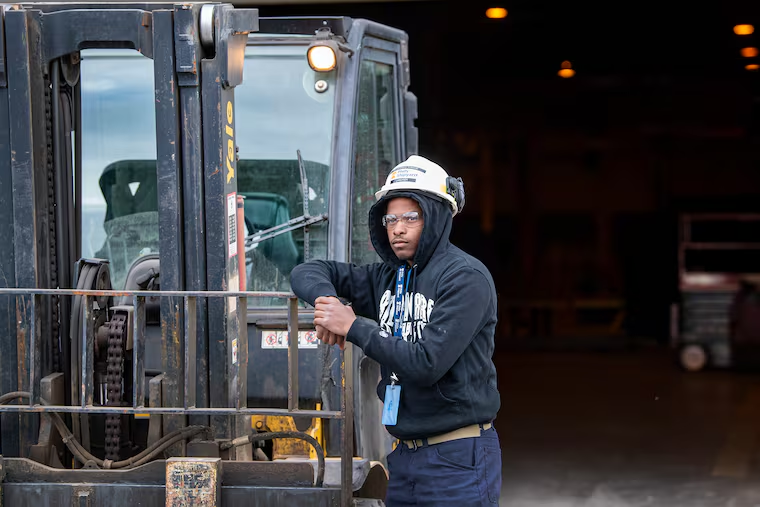A workforce program delivers more recruits to Philly Shipyard
Philly Shipyard has hired more than 600 people in the last 10 months and wants another 400 by next year. It’s using a program started by the West Philadelphia Skills Initiative to find workers.

Ever since he got his first set of Legos, Muhammad Tumaini has loved construction. He took welding classes at Benjamin Franklin High School. And when he visited the Navy Yard complex with a mentor, seeing a ship in dry dock at Philly Shipyard gave him a sense of belonging.
“I knew this is where I wanted to be,” Tumaini, 20, recalled thinking. “From there I made a promise.”
After graduating in 2019, Tumaini enlisted in the Army National Guard, but two years later he found a way into the shipyard: through a workforce development program that’s expanding its partnerships with Philadelphia employers.
Established a decade ago by the University City District, the West Philadelphia Skills Initiative matches job seekers with anchor institutions, including Children’s Hospital of Philadelphia and SEPTA. That model is now being replicated across town at the Navy Yard, with the Philadelphia Industrial Development Corp.
“We build strong, really personal relationships with our employer partner,” said Cait Garozzo, managing director of the West Philadelphia Skills Initiative. “There is very little bait and switch that could happen because we’ve done so much work on the front end.”
The program also puts an emphasis on positions “that have pathways for growth,” said A.J. Adams, program manager for the Navy Yard Workforce Development Initiatives.
Graduates of the three-week training who were hired by the shipyard started at $14 an hour in October. They move up to $15 an hour in January, and, if they’re accepted into the shipyard’s own apprenticeship program, they can earn $17 hourly.
» READ MORE: Philly Shipyard brings in a new generation of apprentices (from June 2021)
To be on that trajectory so quickly, with a chance to learn trade skills early on, “That’s what we consider a quality job,” Adams said. “There’s just a ton of excitement and energy around this opportunity.”
Hiring mode
Philly Shipyard is in hiring mode after winning a contract in April 2020 to build up to five national security multi-mission vessels for the U.S. Maritime Administration. They will be used as training ships for U.S. maritime academies.
“In the last 10 months, we’ve grown by more than 600 people,” said Mike Giantomasso, the shipyard’s vice president for human resources. “And we still need close to another 400 or 500 people by this time next year.”
The laborer position is an entry-level job that can lead to the company’s three-year apprenticeship program. “If you show us you come to work every day, you’re there, we have no problem investing in you,” Giantomasso said.
The most important aspect of recruiting, he said, is making sure the candidate understands the job at hand. “In the shipyard, it’s a different world,” he said. A typical workweek is four 10-hour days, mostly outdoors, no matter the weather.
“It’s a hard job — it definitely is,” said 28-year-old Matt Cabrera, who had a background in sales but wanted to find a job working with his hands.
He earned a spot in the program’s three-week training in September. “They really put you in a position to succeed,” Cabrera said. “It was then up to us to nail the interview and show them we’re not just good on paper.” Cabrera started the job in October, was working on a cutting machine by his second week, and this month took the test for the apprenticeship program.
The skills initiative’s prescreening of candidates impressed the shipyard — so much so that the company plans to work together again.
“They understood. They listened,” Giantomasso said. “I truly believe they have the company and the applicants’ best interest when they go through this process. They’re not numbers-game people.”
» READ MORE: ‘The sun is shining’ at Philly Shipyard as hundreds of jobs return this year, CEO says (from January 2021)
Targeted recruiting
The skills initiative invests a lot of time upfront to understand the employer’s concerns about finding talent, while also getting a feel for the workplace culture.
“We don’t want to provide the employer or the job seeker with any kind of false hope,” said Garozzo. “Part of the secret is, folks are making informed decisions about whether this job is for them.”
All of that information is used to create targeted recruiting materials, and then to provide training that matches what the employer is looking for in an ideal candidate.
For the first cohort that went to the shipyard: 20 people were invited to join the training, 14 graduated, and 13 received initial offers to join as laborers.
Tumaini said the best part of the training was the safety instruction he received. Another benefit was starting a new job with fellow classmates.
“I’m proud of my cohort,” he said. “We’re not being dropped into an environment where we don’t know anybody.”
That’s by design. Classmates aren’t competing against each other for too few spots. “If you feel connected to other people at your job, you’re much more likely to be satisfied at your job,” Garozzo said. And greater satisfaction can lead to greater retention.
Both Cabrera and Tumaini envision careers for themselves at the shipyard.
“I’m building an arsenal,” Tumaini said. “Right now I want to learn everything — anything and everything, as much as I can.”